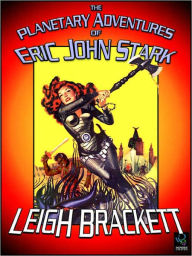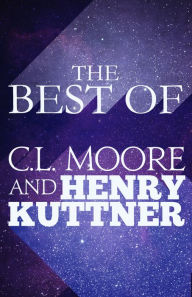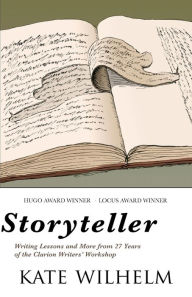The Better Halves of Three Pioneering Science Fiction Writing Couples
 At this year’s Hugo Awards, an unprecedented number of shiny rocket trophies went to women writers.
At this year’s Hugo Awards, an unprecedented number of shiny rocket trophies went to women writers.
And yet, despite the strong female presence in science fiction and fantasy awards over the past few years, women still face struggles in the field, from online harassment to readers who question their credibility. It’s one thing the future hasn’t changed—and if anything, things were a lot harder for women in the genres’ earlier years. In those days, making it in sci-fi and fantasy as a woman was rare indeed, and some of those that did likely found support from male spouses who also wrote. Which isn’t to say these women didn’t earn every bit of their success—in the case of three women in particular, these “writer’s wives” more than held their own, and even outshone their husbands.
The Planetary Adventures of Eric John Stark
The Planetary Adventures of Eric John Stark
In Stock Online
eBook
$3.99
$5.99
Leigh Brackett (1915-1978) was married to Edmond Hamilton (1904-1977). Hamilton was an early pioneer in space opera alongside E. E. Smith, and his books include Captain Future, Interstellar Patrol, and Star Kings. He also wrote extensively for DC Comics. Obviously he made a good match for Brackett, now often called the Queen of Space Opera. Her best known SF character was Eric John Stark, an orphan from Earth raised by the aboriginals of Mercury.
With her ambiguous first name, Brackett was not, to readers, an obviously a female writer. Impressed by her mystery novel No Good From a Corpse, legendary director Howard Hawks asked his secretary to call in “this guy Brackett” to co-write the script for the Humphrey Bogart movie The Big Sleep. Hawks subsequently hired Brackett to write or co-write a number of other scripts, including John Wayne movies like Rio Bravo and Hatari! Back in SF, she also wrote the first draft of a little movie called The Empire Strikes Back, based on George Lucas’s story, just before her death. That draft was rewritten by Lucas, then Lawrence Kasdan, but its bones are visible in the finished film, and Brackett and Kasdan shared final credit for the screenplay, which won a Hugo Award. As a couple, Brackett and Hamilton only collaborated once; that story, “Stark and the Star King,” was originally destined for Harlan Ellison’s Last Dangerous Visions, and eventually escaped that quagmire to see print in 2005.
Leigh Brackett (1915-1978) was married to Edmond Hamilton (1904-1977). Hamilton was an early pioneer in space opera alongside E. E. Smith, and his books include Captain Future, Interstellar Patrol, and Star Kings. He also wrote extensively for DC Comics. Obviously he made a good match for Brackett, now often called the Queen of Space Opera. Her best known SF character was Eric John Stark, an orphan from Earth raised by the aboriginals of Mercury.
With her ambiguous first name, Brackett was not, to readers, an obviously a female writer. Impressed by her mystery novel No Good From a Corpse, legendary director Howard Hawks asked his secretary to call in “this guy Brackett” to co-write the script for the Humphrey Bogart movie The Big Sleep. Hawks subsequently hired Brackett to write or co-write a number of other scripts, including John Wayne movies like Rio Bravo and Hatari! Back in SF, she also wrote the first draft of a little movie called The Empire Strikes Back, based on George Lucas’s story, just before her death. That draft was rewritten by Lucas, then Lawrence Kasdan, but its bones are visible in the finished film, and Brackett and Kasdan shared final credit for the screenplay, which won a Hugo Award. As a couple, Brackett and Hamilton only collaborated once; that story, “Stark and the Star King,” was originally destined for Harlan Ellison’s Last Dangerous Visions, and eventually escaped that quagmire to see print in 2005.
The Best of C.L. Moore & Henry Kuttner
The Best of C.L. Moore & Henry Kuttner
By Henry Kuttner , C.L. Moore
In Stock Online
eBook $2.99
Things were different for another pair of married SFF writers, C. L. Moore (1911-1987) and Henry Kuttner (1915-1958). They were both published authors before they met, but once they married, almost everything they wrote was a collaboration. (And Moore wrote very little after Kuttner died.) In print, Catherine Lucille Moore went with her initials to obscure her gender. It seemed to work, since the first contact between the two was a fan letter Kuttner wrote to Moore, thinking that she was a man. Some of their collaborations were published under both their real names, but they also used a number of pseudonyms, including Lawrence O’Donnell for “Vintage Season” and Lewis Padgett for “Mimsy Were the Borogroves,” collected in The Best of C. L. Moore and Henry Kuttner. The latter eventually became a film, more or less.
Even after Moore stopped writing fiction, she remained active in the field, teaching a writing course at the University of Southern California and being active in the Tom and Terri Pinkard Science Fiction Literary Salon. In 1981, Moore won the World Fantasy Award for Lifetime Achievement, as well as the Gandalf Award from the World Science Fiction Society. She was also nominated to be the first female Grand Master by the Science Fiction and Fantasy Writers of America. However, by that time she had developed Alzheimer’s disease, and her second husband Thomas Reggie asked that the nomination be withdrawn. He felt the awards ceremony would at best be confusing for her, and possibly quite upsetting.
Things were different for another pair of married SFF writers, C. L. Moore (1911-1987) and Henry Kuttner (1915-1958). They were both published authors before they met, but once they married, almost everything they wrote was a collaboration. (And Moore wrote very little after Kuttner died.) In print, Catherine Lucille Moore went with her initials to obscure her gender. It seemed to work, since the first contact between the two was a fan letter Kuttner wrote to Moore, thinking that she was a man. Some of their collaborations were published under both their real names, but they also used a number of pseudonyms, including Lawrence O’Donnell for “Vintage Season” and Lewis Padgett for “Mimsy Were the Borogroves,” collected in The Best of C. L. Moore and Henry Kuttner. The latter eventually became a film, more or less.
Even after Moore stopped writing fiction, she remained active in the field, teaching a writing course at the University of Southern California and being active in the Tom and Terri Pinkard Science Fiction Literary Salon. In 1981, Moore won the World Fantasy Award for Lifetime Achievement, as well as the Gandalf Award from the World Science Fiction Society. She was also nominated to be the first female Grand Master by the Science Fiction and Fantasy Writers of America. However, by that time she had developed Alzheimer’s disease, and her second husband Thomas Reggie asked that the nomination be withdrawn. He felt the awards ceremony would at best be confusing for her, and possibly quite upsetting.
Where Late the Sweet Birds Sang
Where Late the Sweet Birds Sang
By Kate Wilhelm
Paperback
$18.04
$18.99
The last, and perhaps the most influential couple we’ll discuss today, is Damon Knight (1922-2002) and Kate Wilhelm, who turned 89 this year. As an author, Knight best known story is “To Serve Man,” adapted for a Twilight Zone episode and winner of the Retro Hugo for the Best Short Story of 1950. He was also a noted SF critic, and won the Hugo Award for Best Reviewer in 1956. Knight headed a group from the Milford Writer’s Conference that founded the Science Fiction Writers of America (now the Science Fiction and Fantasy Writers of America) in 1965. Knight was the organization’s first president, and SWFA’s Grand Master Award was renamed the Damon Knight Memorial Grand Master Award after he died in 2002.
Kate Wilhelm, meanwhile, was a more prolific writer of science fiction, fantasy, and mystery. Three of her short works won the Nebula Award (a trophy designed by J. A. Lawrence based on a sketch by Wilhelm). Her novel Where Late the Sweet Birds Sang won the Hugo and Locus Awards for Best Novel, and was nominated for the Nebula. She also received one of the inaugural Solstice Awards in 2009, given by the Science Fiction and Fantasy Writers of America for significant impact on the science fiction and fantasy community. In 2016, that honor was renamed the Kate Wilhelm Solstice Award.
The last, and perhaps the most influential couple we’ll discuss today, is Damon Knight (1922-2002) and Kate Wilhelm, who turned 89 this year. As an author, Knight best known story is “To Serve Man,” adapted for a Twilight Zone episode and winner of the Retro Hugo for the Best Short Story of 1950. He was also a noted SF critic, and won the Hugo Award for Best Reviewer in 1956. Knight headed a group from the Milford Writer’s Conference that founded the Science Fiction Writers of America (now the Science Fiction and Fantasy Writers of America) in 1965. Knight was the organization’s first president, and SWFA’s Grand Master Award was renamed the Damon Knight Memorial Grand Master Award after he died in 2002.
Kate Wilhelm, meanwhile, was a more prolific writer of science fiction, fantasy, and mystery. Three of her short works won the Nebula Award (a trophy designed by J. A. Lawrence based on a sketch by Wilhelm). Her novel Where Late the Sweet Birds Sang won the Hugo and Locus Awards for Best Novel, and was nominated for the Nebula. She also received one of the inaugural Solstice Awards in 2009, given by the Science Fiction and Fantasy Writers of America for significant impact on the science fiction and fantasy community. In 2016, that honor was renamed the Kate Wilhelm Solstice Award.
Storyteller: Writing Lessons and More from 27 Years of the Clarion Writers' Workshop
Storyteller: Writing Lessons and More from 27 Years of the Clarion Writers' Workshop
By Kate Wilhelm
Paperback
$14.80
$16.00
A large part of the reason Wilhelm won the Solstice was for her work, along with Knight, to mentor younger SF writers. In the 1950s, the two of them, along with some others, started the Milford Science Fiction Writer’s Workshop in Milford, Pennsylvania, where they lived. This week-long residential workshop gave professional SF writers a venue to share criticism of each other’s work. Now called the Milford Writer’s Conference, this annual event is still running, and the Milford model of mutual criticism was part of the system Robin Scott Wilson used when he started the famed Clarion Writer’s Workshop in 1968, an intensive six week summer workshop for aspiring science fiction writers focusing on the fundamentals of writing short science fiction.
Wilhelm and Knight helped Wilson establish Clarion and were teachers in the workshop for many years. Bruce Sterling, Kim Stanley Robinson, and Octavia Butler are among the many distinguished Clarion alumni. Wilhelm won a Hugo Award for Best Related Work in 2006 for Storyteller: Writing Lessons and More from 27 Years of the Clarion Writer’s Workshop. And she continues to write, with the fourteenth book in her Barbara Holloway Mystery series Mirror, Mirror just published in February 2017.
I imagine Kate Wilhelm is happy to have lived long enough to see women so widely recognized for their work in SFF—work women have always done, no help from men required, thank you very much.
A large part of the reason Wilhelm won the Solstice was for her work, along with Knight, to mentor younger SF writers. In the 1950s, the two of them, along with some others, started the Milford Science Fiction Writer’s Workshop in Milford, Pennsylvania, where they lived. This week-long residential workshop gave professional SF writers a venue to share criticism of each other’s work. Now called the Milford Writer’s Conference, this annual event is still running, and the Milford model of mutual criticism was part of the system Robin Scott Wilson used when he started the famed Clarion Writer’s Workshop in 1968, an intensive six week summer workshop for aspiring science fiction writers focusing on the fundamentals of writing short science fiction.
Wilhelm and Knight helped Wilson establish Clarion and were teachers in the workshop for many years. Bruce Sterling, Kim Stanley Robinson, and Octavia Butler are among the many distinguished Clarion alumni. Wilhelm won a Hugo Award for Best Related Work in 2006 for Storyteller: Writing Lessons and More from 27 Years of the Clarion Writer’s Workshop. And she continues to write, with the fourteenth book in her Barbara Holloway Mystery series Mirror, Mirror just published in February 2017.
I imagine Kate Wilhelm is happy to have lived long enough to see women so widely recognized for their work in SFF—work women have always done, no help from men required, thank you very much.



